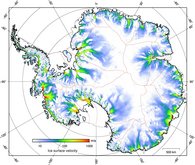The Antarctic ice sheet gains mass by surface snow accumulation which over time compacts to ice. The ice flow from the interior of the AIS towards its margins is caused by gravity and is the combined result of creep flow and basal sliding. The flow follows the ice sheet surface gradient and reaches surface velocities in the order of meters per year in the inner regions of the ice sheet. At the ice sheet margins, the ice flow is dominated by several fast flowing ice streams. They transport large amounts of ice at velocities of up to several hundred meters per year towards the coast or are feeding into adjacent ice shelves. There, the mass loss is dominated by two processes in approximately equal shares: First, mass is lost by calving of glaciers and ice shelves where ice breaks off and forms icebergs. Second, the floating ice shelves loose mass at their base by melting due to the ocean heat flux. In comparison, only a vanishing low portion is contributed by ice melting at the base of grounded ice and by surface melting (only at the Antarctic Peninsula).


